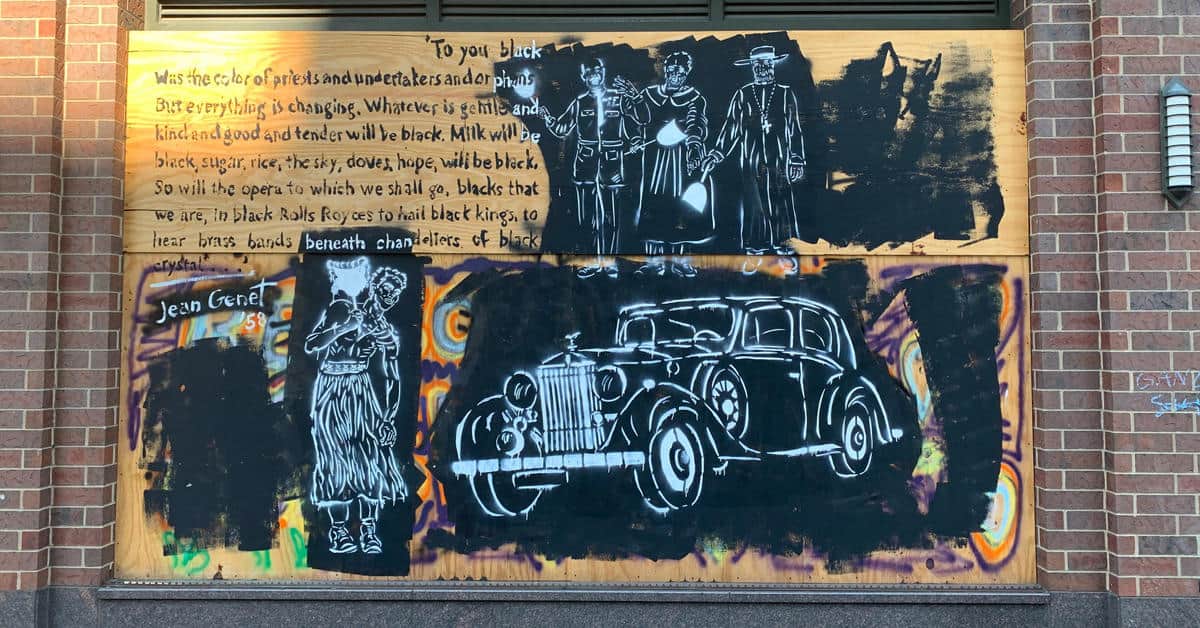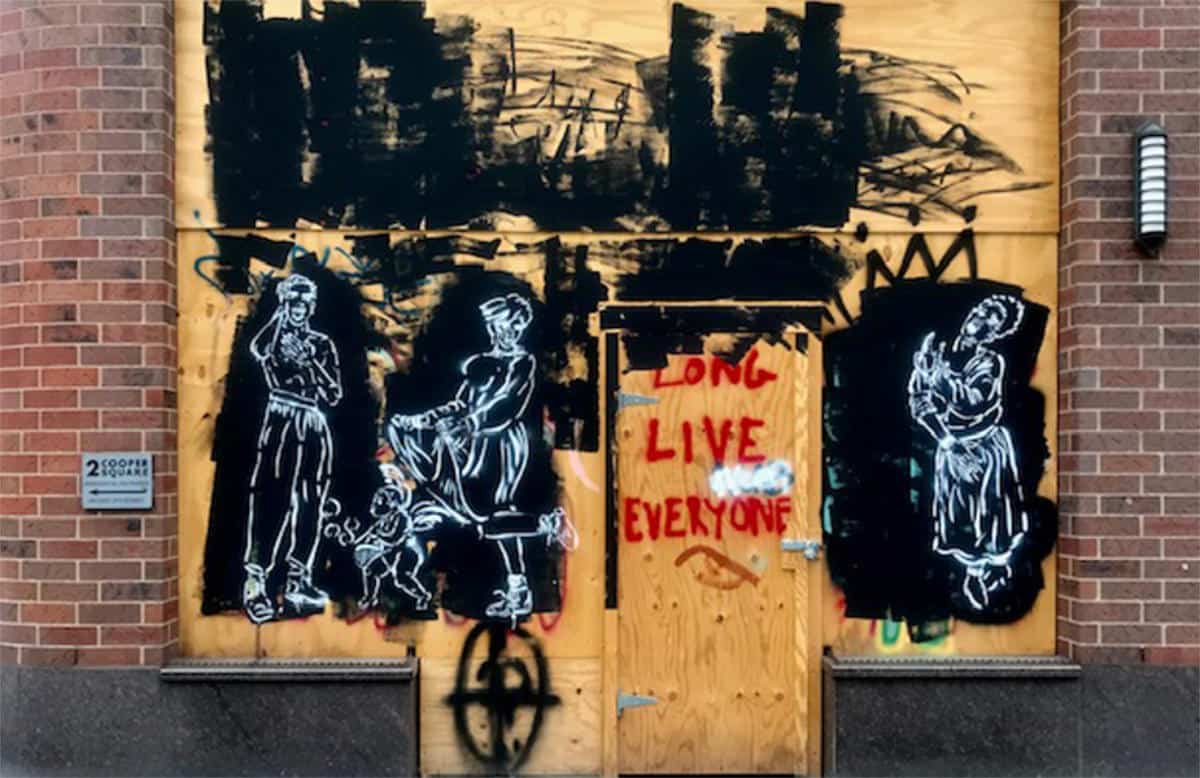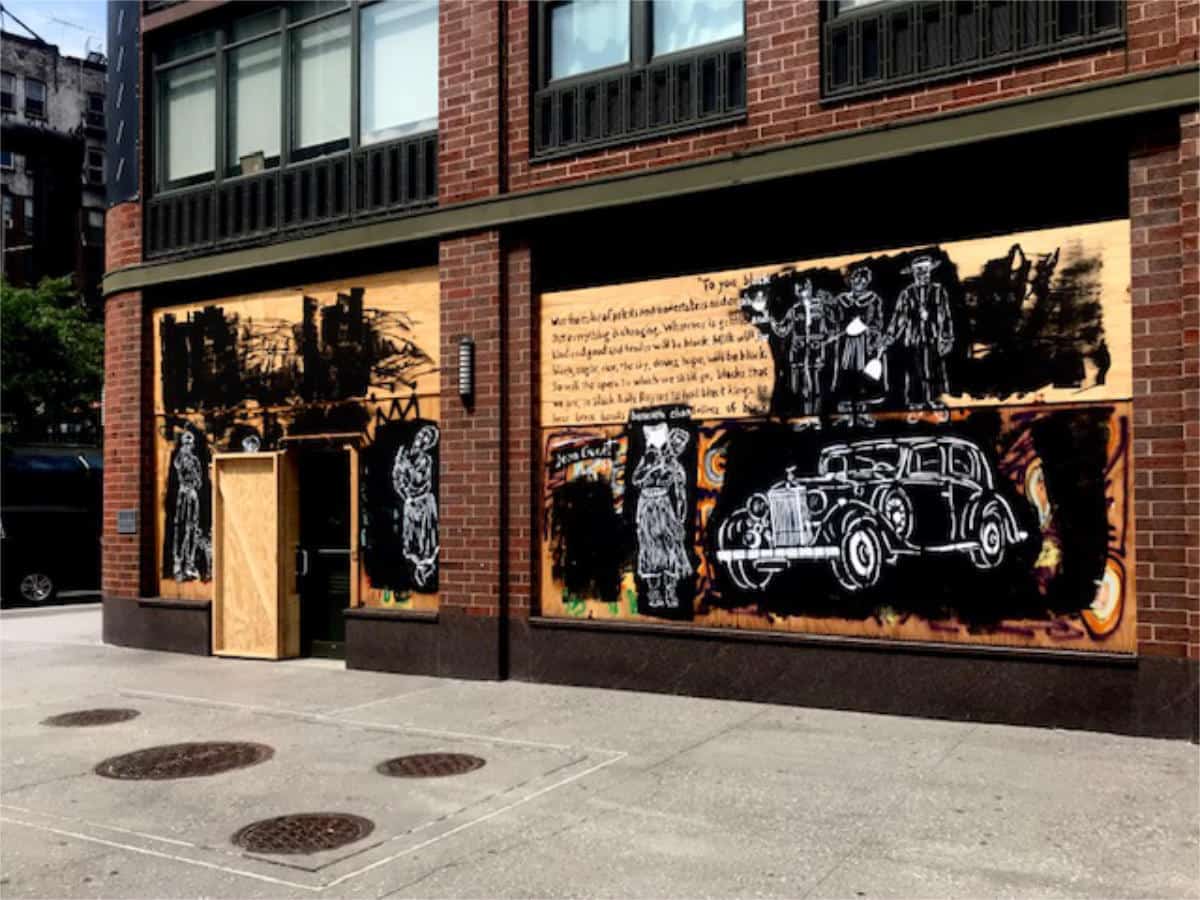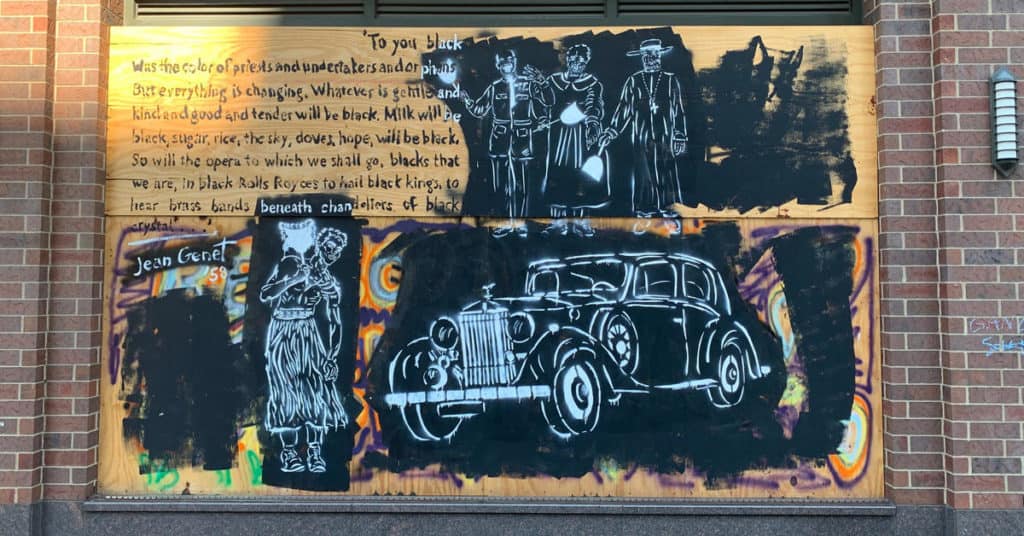Izhar Patkin Murals on View at Howl! Happening

Whatever is gentle and kind and good and tender will be black. Milk will be black; sugar, rice, the sky, doves, hope, will be black. So will the opera to which we shall go, blacks that we are, in black Rolls Royces to hail black kings, to hear brass bands beneath chandeliers of black crystal…
A quote from a speech by Felicity, a character in Jean Genet’s play The Blacks, is the starting point for the murals Izhar Patkin painted of characters and “staging” elements from his monumental work, The Black Paintings, 1986 (Collection of the Museum of Modern Art, New York). A painterly narrative of Genet’s play, Patkin’s The Black Paintings is one of the most significant and inventive works to come out of the East Village in the 80s.
Drawn from the cast of 13 characters modeled by his friends, the murals are a preview of The Making of The Black Paintings, a full-scale exhibition of Patkin’s early work, curated by SSB, that has been postponed due to the COVID-19 pandemic and rescheduled at Howl for September 2021. The murals will be on view as part of Bringing Back Bowery: Public Art as Protest at Howl! Happening, Thursday, August 13 through Sunday, August 23 from 11 AM to 6 PM. (See Visitor Guidelines below) ***
One evening an actor asked me to write a play for an all-black cast. But what exactly is a black? First of all, what’s his color.
Having immigrated from Israel in the late 70s, The Black Paintings was Patkin’s way of sorting out the terms and mythologies of his new American homeland. He was drawn to Genet’s play as a narrative device for paintings that tap into a wide range of visual metaphors challenging the binaries of black and white. Patkin was drawn to the play because, as he says: “When Genet asks: ‘First of all, what’s his color?’ he questions and inverts these artificial dualities. I felt Genet was painting the play, not just writing it.”
Among the ironies of Genet’s The Blacks is the fact that this protest against the white world was itself written by a white man. The playwright’s ability to identify with victims of oppression owed much to his own identity as an orphan, a homosexual, and a convict. Genet’s rage and frustration are contained within a highly disciplined art form and channeled through humor and constant inversion.
This play, written, I repeat, by a white man, is intended for a white audience, but if, which is unlikely, it is ever performed before a black audience, then a white person, male or female, should be invited every evening. The organizer of the show should welcome him formally, dress him in ceremonial costume and lead him to his seat, preferably in the first row of the orchestra. The actors will play for him. A spotlight should be focused upon this symbolic white throughout the performance. But what if no white person accepted? Then let white masks be distributed to the black spectators as they enter the theater. And if the blacks refuse the masks, then let a dummy be used.
—Genet’s prelude to The Blacks
Genet’s play commemorates Ghana’s 1957 independence and comments on the supremacist ideologies that underpinned colonialism—its black characters trapped within negative perceptions of blackness while the whites are caricatures of imperial cruelty, of “whiteness.” Written for Belgian director Raymond Rouleau’s all-black theater company, it was first performed at Le théâtre de Lutèce in Paris in 1959.
When it premiered in New York City at the St. Mark’s Playhouse in 1961, The Blacks was the longest-running off-Broadway non-musical of the decade. Directed by Gene Frankel, the cast featured James Earl Jones, Louis Gossett Jr., Cicely Tyson, Godfrey Cambridge, and Maya Angelou.

Each of us is here now because in one way or another we share a commitment to language and the power of language, and to the reclaiming of that language which has been made to work against us. In the transformation of silence into language and action, it is vitally necessary for each one of us to establish or examine her function in that transformation and to recognize her role as vital within that transformation.
That was then. Now we live a world where the masks are off the monsters. Everything is up for discussion. So much has changed since we started the process of curating the exhibition more than three years ago. We are called upon to reaffirm the plurality of voices, experience, scholarship, and activism needed to contextualize this show and to further enrich the public programs—co-curated by Howl education director Katherine Cheairs—which were designed to encourage dialogue and discussion around the ontologies of race, identity, and cultural programming.
The pandemic and the Black Lives Matter movements foreground the necessity for yet more scrutiny and awareness of our beliefs and collective pain. SSB stands with artists and all those who are in the vanguard of social and cultural innovation. Those who consistently stand up and call out oppression, and question values, standards, and intention. “Metaphors create identity. They are the DNA of language, predictive of hereditary cultural diseases,” Patkin asserts. “We live in the age of correction, but we need reinvention. As a painter, I don’t use black as the opposite of white. They are colors among colors. With Genet as my dramaturge, The Black Paintings are my way to repudiate how these binaries are encountered in language and everyday life.”
*** To ensure the safety of visitors, entry will be limited to 10 people at a time. Visitors must wear masks, maintain social distancing, and register upon entry (name, email or phone number). Temperatures will be taken at the door, and people with a fever will not be admitted. RSVP to contact@howlarts.org


